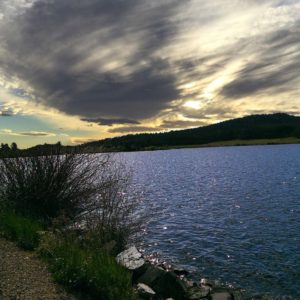Cheyenne Municipal Watershed Wildfire Hazard Mitigation
Evaluating potential fire risk and water quality impacts to minimize future water supply system risks.
In 2002, the Hayman Fire burned an estimated 138,000 acres northwest of Colorado Springs—the largest wildfire in the state’s recorded history. Colorado experienced more devastating fires during the summer of 2010, including the Waldo Canyon fire that burned over 15,000 acres in the Colorado Springs area. These events in Colorado and their downstream impacts led to millions of dollars in added costs for water treatment and reservoir rehabilitation. The magnitude of the costs incurred as a result of these fires led Wyoming to initiate an effort to evaluate risks from potential wildfires. The National Cohesive Wildland Fire Management Strategy was adopted in 2014, and Wyoming Governor Matt Mead responded by creating a Task Force on Forests that outlined how the state will address the new national strategy. The final report for the Governor’s Task Force on Forests in Wyoming recommends developing “cross-jurisdictional watershed protection plans for municipal water supply drainages that focus on proactive management to preserve and enhance water quality.”
The Cheyenne Municipal Watershed Wildfire Hazard Mitigation Assessment was conducted for the Wyoming Water Development Office (WWDO) in partnership with the Cheyenne Board of Public Utilities (BOPU) to support the objectives outlined in the final report of the Governor’s Task Force on Forests. The water supply system for the city of Cheyenne is a complicated system that involves various water rights, collection systems, storage reservoirs, pipelines, and natural channels. As a result, the project area spans four river basins in Wyoming: Little Snake River, Upper North Platte River, Upper Laramie River, and Crow Creek. The goal of this project was to create a watershed management plan that outlined site-specific forest management treatments to prevent or minimize the impact of catastrophic wildfires to municipal supply reservoirs and infrastructure for the city of Cheyenne.
RESPEC teamed with Anchor Point Group, which is a company that focuses on hazard and risk methodology. The Anchor Point Group’s methodology incorporates advanced fire-behavior-prediction methods and uses local information about fuel, weather, topography, and the built environment to generate hazard and risk output data. Using this approach ensures a level of detail that is necessary for identifying fuels-reduction projects while using core modeling systems recognized by the federal agencies. Fire-behavior predictions and topographic, soil survey, and precipitation-frequency distribution data were used to conduct a postfire hydrologic hazard assessment that identified areas within the water supply drainages that were most likely to contribute large sediment loads to critical infrastructure. This information will then be interpreted and weighted along with prioritization criteria, including information about previous, ongoing, and planned projects, permitting and funding requirements, and stakeholder input, to build a prioritized, actionable, Preemptive Watershed Wildfire Mitigation Plan.



Stay in Touch